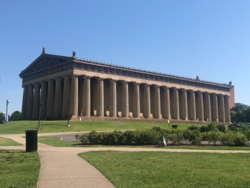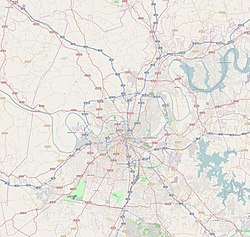The Parthenon | |
 The Parthenon in Nashville's Centennial Park is a full-scale copy of the original Parthenon in Athens. | |
| Location | Nashville, Tennessee, United States |
|---|---|
| Coordinates | 36°8′59″N 86°48′48″W / 36.14972°N 86.81333°W |
| Built | 1897 (original structure) 1925–1931 (permanent version) |
| Architect | William Crawford Smith[2][3] |
| Architectural style | Classical |
| NRHP reference No. | 72001236[1] |
| Added to NRHP | February 23, 1972 |


The Parthenon in Centennial Park, Nashville, Tennessee, United States, is a full-scale replica of the original Parthenon in Athens, Greece. It was designed by architect William Crawford Smith[4][5] and built in 1897 as part of the Tennessee Centennial Exposition.
Today, the Parthenon, which functions as an art museum, stands as the centerpiece of Centennial Park, a large public park just west of downtown Nashville. Alan LeQuire's 1990 re-creation of the Athena Parthenos statue in the naos (the east room of the main hall) is the focus of the Parthenon just as it was in ancient Greece. Since the building is complete and its decorations were polychromed (painted in colors) as close to the presumed original as possible, this replica of the original Parthenon in Athens serves as a monument to what is considered the pinnacle of classical architecture. The plaster replicas of the Parthenon Marbles found in the Treasury Room (the west room of the main hall) are direct casts of the original sculptures which adorned the pediments of the Athenian Parthenon, dating to 438 BC. The surviving originals are housed in the British Museum in London and at the Acropolis Museum in Athens.
- ^ "National Register of Historical Places - Tennessee (TN), Davidson County". National Register of Historic Places. National Park Service. March 3, 2007.
- ^ Coleman, Christopher K. (Fall 1990). "From Monument to Museum: The Role of the Parthenon in the Culture of the New South". Tennessee Historical Quarterly. 49 (3): 140. JSTOR 42626877.
- ^ "Valor's Reward Paid His Memory. Tablet Unveiled to the Memory of Col. C. W. Smith. On Walls of the Parthenon. Rare Tribute Paid the Name of Soldier-Architect. Tully Brown and Lieut. Caruthers Deliver Addresses of Occasion Before Several Hundred People, Among Whom Were Comrades of Two Wars". The Nashville American. Nashville, Tennessee. July 6, 1903. pp. 5, 7. Retrieved November 22, 2015 – via Newspapers.com.

- ^ Cite error: The named reference
:0was invoked but never defined (see the help page). - ^ Cite error: The named reference
:1was invoked but never defined (see the help page).


